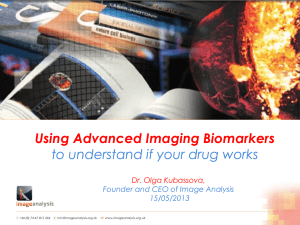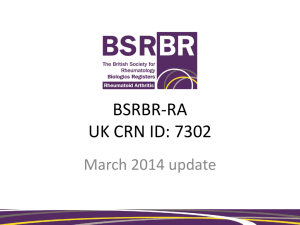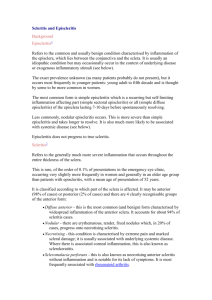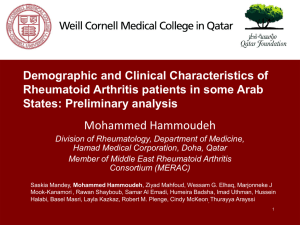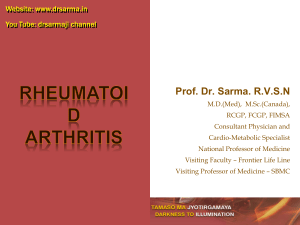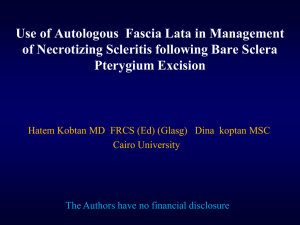Scleromalacia - University of Louisville Department of
advertisement
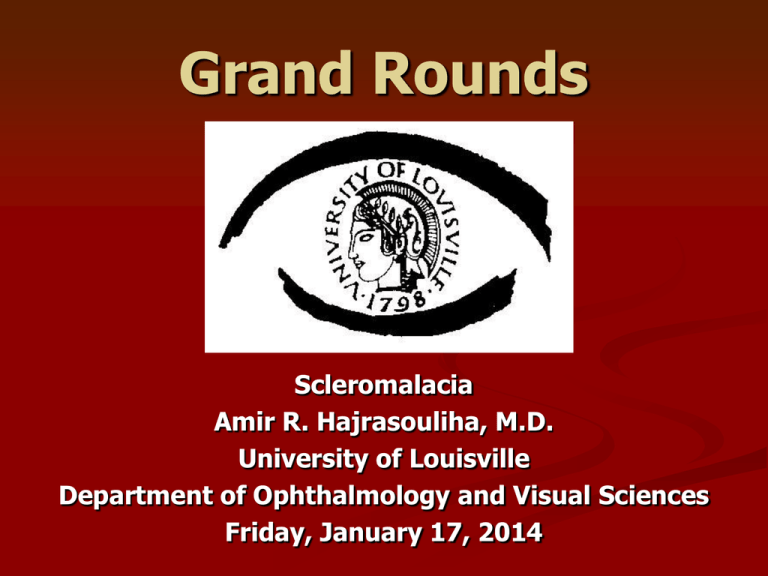
Grand Rounds Scleromalacia Amir R. Hajrasouliha, M.D. University of Louisville Department of Ophthalmology and Visual Sciences Friday, January 17, 2014 Patient Presentation HPI: 79 y/o white male present for annual work up. He has a h/o dry AMD with no new complaint. He has no pain or discomfort. Patient Presentation POH: AMD dry PMH: Rheumatoid arthritis H/o bladder cancer AREDS Plaquenil 400mg for 16 years (2,304g total) NKDA No tobacco, no ETOH Negative (No joint pain and swelling now) Meds: Allergies: SH: ROS: Exam VA cc 20/40 20/25 EOM: Full OU P 32mm (-) RAPD OU 32mm CVF: FULL OU TTP 13 12 Anterior exam Ext L/L Conj K AC Iris Lens OD OS wnl wnl sup and temp scleral thinning clear formed wnl 2+ NS wnl wnl wnl clear formed wnl 2+NS Photos Assessment 79 year old male with rheumatoid arthritis and scleral thinning without inflammation OD •Differential Diagnosis •scleromalacia Plan Referral to rheumatologist Scleromalacia Also known as necrotizing scleritis without inflammation. It is clinically distinct from other forms of anterior scleritis in which typical signs (redness, edema) and symptoms (pain) of inflammation are not apparent. Scleromalacia Typically occurs in patient with long standing rheumatoid arthritis. It has been also reported to have association with Wegener's granulomatosis, SLE, JRA, PAN, Relapsing Polychondritis, psoriasis, gout, TB, syphilis, HSV, HZV. Scleromalacia A bulging staphyloma develops if intraocular pressure is elevated; Spontaneous perforation is rare, although these eye may rupture with minimal Trauma. Case report A clinical case of scleromalacia perforans in a 56-year-old woman with 20 years of seropositive rheumatoid arthritis. She developed rapidly progressed to scleromalacia perforans OS and became perforated. It was surgically enucleated, and the patient was maintained with steroidal therapy. 2 months later she developed new-onset scleromalacia OD. She was first evaluated by a rheumatologist and treated with 200 mg/dose of infliximab, which was administered monthly for the following four months. The biological treatment was accompanied by methotrexate and prednisone. With this therapy, the ocular lesion dramatically improved, and complete remission of rheumatoid arthritis and scleritis was archived four months later. In conclusion, tumur necrosis factor (TNF) blockers are effective therapeutic agents in ocular complications of rheumatoid arthritis. Reumatismo. 2009 Jul-Sep;61(3):212-5.Infliximab treatment in a case of rheumatoid scleromalacia perforans. MEDICAL TREATMENT In patients with simple diffuse or nodular scleritis systemic non-steroidal antiinflammatory drug therapy is almost invariably effective For unresponsive cases and posterior scleritis, the mainstay of treatment is systemic steroids in a dose of 1 mg/kg/day. As soon as the patient responds, the dose should be tapered once 20 mg/day is reached, alternate day therapy can be started. Topical steroids can be applied for symptom relief. Immunosuppressive therapy is mandatory for definitively diagnosed systemic vasculitic disease and/or progressive destructive ocular lesions. If the necrotizing scleritis is not severe, not rapidly progressing, the first choice of therapy is methotrexate 7.5 mg once a week as a starting dose Scleromalacia Extreme corneal thinning or perforation requires reinforcement. Donor sclera, fascia lata, periosteum or artificial materials can be used. To maintain its integrity the material must be covered by conjunctiva. Thank You



